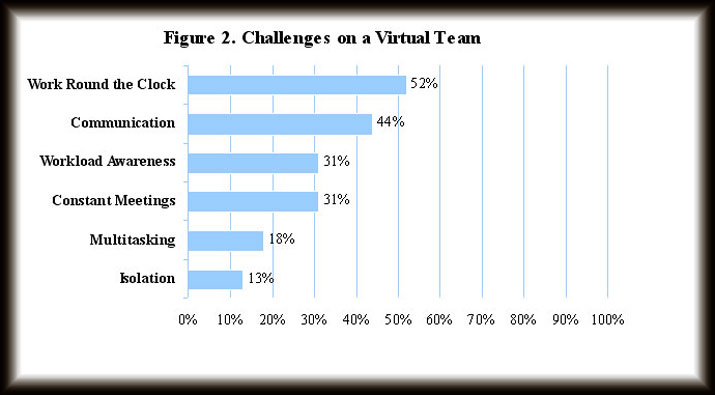Volume 9 · Issue 2
WELCOME to our e-newsletter.
As many of you know, I have completed my latest book, A Manager’s Guide to Virtual Teams. In preparation for this book, we analyzed data from interviews we conducted with 150+ virtual team (VT) members, managers and CEOs from diverse industries and countries over a period of 10 months. Countries and cultures from five continents were represented – Asia, North America, South America, Africa and Europe. The research is particularly interesting because it covers a diverse range of industries across the globe, from Health Care to Software, from Financial Services to Retail, from Manufacturing to Aviation. The AIM Team created a short report that summarizes trends uncovered in these interviews. Interview questions identified four key areas common to VTs: communication, trust, conflict and deliverables. While interviews were conducted to determine commonalities around these four areas (which the upcoming book explores in depth), we also found several notable trends, such as: (1) the frequency of team ‘check-ins’ as a determinant of success and (2) the need for tight coordination of work schedules across a wide span of time zones. In addition, we found a lack of a universally accepted definition for the term ‘virtual team’. (All of these concepts will be thoroughly explored in the new book).
I am pleased to present the findings of our research and will share highlights with you in this AIM News Fall Edition. Your thoughts or questions are welcome. Please feel free to contact AIM Strategies®.
Very truly yours, Yael Zofi
- Many Definitions–One Team
- Trend Highlights
- Virtual Team Trend Report – Finding & Podcast
- About AIM Strategies®
At the inception of this project we believed that the term ‘virtual team’ had a universal meaning. As the interviews progressed, we realized that a consistent definition of the term ‘virtual team’ did not exist. Interviewees agreed that VTs are important, yet a unanimous understanding of what a VT is did not surface.Some individuals focused on the elements related to “VIRTUAL” (physical locations, time zones, boundaries), while others focused on “TEAM” structure (number of people, how they operate – temporary projects or ongoing and intact, reporting relationship). Still others focused on a third theme of TECHNOLOGY as an enabler of communication. The challenge is to come up with a definition that captures all three themes.
Physical Elements
Although we expected physical distance between members to be mentioned as a pre-requisite for a VT, only 75% specifically included this element (Figure 1). Some definitions noted that members can work in different countries or on different floors of a building. Regardless of location, 13% noted the infrequency of face-to-face meetings as a factor in working virtually
Team Elements
The next dimension was the structure of teams. 13% believed cross-functional elements are sufficient to consider a team virtual, as its members work together in different roles. 8% reported that their team lacked a formal reporting structure; in some cases there were no team leaders, or team leaders were not responsible for directly writing performance reviews. In contrast, 4% specifically mentioned having to report to an assigned leader. Lastly, 8% noted that their team was assembled for a limited time period in order to complete a specific short term project.
Technology Elements
Technology as a communication vehicle across these distances emerged as another theme. Although all teams interviewed used some form of technology, it was noted as a core element by a fifth of participants (21% in Figure 1), while the remaining 79% did not highlight their implicit use of technology.We did find a unifying thread in our interviews. Each individual noted that some physical distance existed between colleagues, regardless whether or not this factor was included in their definition.
Our Definition
At AIM Strategies®, we opted for a simple definition of the term virtual team, as follows:
“A virtual team – whether its members work across the street or across the world – is a team whose members simultaneously work together to achieve a common purpose, while physically apart.”
Trend 1: Communicating When Every Time Zone Is Your Time Zone
With teammates dispersed throughout the globe, members observed fewer established time boundaries and often worked around the clock (52%). Coordinating across time zones caused communication problems (44%), and excessive multitasking (18%) during conversations caused further obstacles. Strikingly, isolation (13%) was not a significant concern even for those working from a home office.
Trend 2: Building A Human Connection While Replacing Hallway Chats
Even in the virtual environment, occasional face-to-face communication was considered vital for certain aspects of team interaction, such as team set-up (24%) and conflict resolution (27%). Some teams highlighted bi-annual or quarterly face-to-face meetings as significantly improving performance – yet other well functioning teams never met at all. On the other hand, building relationships through trust did not require face-to-face communication as trust was reportedly enhanced through regular contact (e.g., phone/email, etc.) with other team members (63%). Despite the need for building a human connection, teams did not uniformly utilize the alternative form of “virtual face-to-face” or visual technologies, which remains an open opportunity for improved virtual techniques.
Trend 3: Conflict – When Conflict Arises, Virtual Team Members Do Not Hide Behind Their Screen
The sources of conflicts differ from on-site teams, as the lack of visual cues causes an increase in miscommunication (33%) or inconsistent expectations (21%). VT members used a variety of resolution styles, such as phone calls (40%) and mediation (18%). Language barriers (13%) and written misunderstandings, such as email (8%) were also considered sources of conflict. Although it is easy to hide behind a computer screen and to ignore phone calls and emails when a conflict arises, only 7% of respondents used avoidance techniques.
Trend 4: Cross Cultural Communication – Lost In Translation
Cross cultural elements play a role in the effectiveness of VTs. The most common communication barrier found stemmed from misunderstandings related to the use of English (47%), which included both varying interpretations of the same words in different cultures as well as differences in overall competency levels. Meanwhile, accents did not play a significant role, as only 10% indicated they were a challenge.
Trend 5: Speed Of Virtual Team Delivery – Slow And Steady Does Not Win The Race
The speed of communication and timelines of deliverables vary significantly as compared to on-site teams. VTs experience shorter deadlines (17%), often on a weekly or even daily basis, as well as more frequent checkpoints between deadlines. 90% of teams held meetings each week, while some met team-wide three or more times per week (8%).To begin, consider the types of networks you already have, the specific networks within each type, and how you can make them even more effective. For example, if you belong to a professional association in Finance, consider volunteering on a committee to give yourself greater visibility. In addition, think of the types of networks you do not have now, but believe would be beneficial in the future.
I invite you to read through the Virtual Teams Trends Report and listen to the Podcast by clicking below. As always, your thoughts and suggestions are welcome. Yael Zofi
AIM Strategies® Applied Innovative Management® is a results-driven Human Capital Consulting firm specializing in the areas of: Global Leadership Development, Co-located and Virtual Team Facilitation, Cross Cultural Communications, and Change Integration Services. To request information about AIM’s experiential learning methods (5D’s™ Consulting/Proprietary Training Methodology and ACT™ Coaching Process), please email info@aim-strategies.com. In upcoming issues of this newsletter, we’ll update you on tips and techniques related to raising your innovative management IQ. We are confident that the solutions we develop fit your needs and culture. Please forward this newsletter to your colleagues and visit www.aim-strategies.com to learn more about how our services unlock the people potential of your organization!




